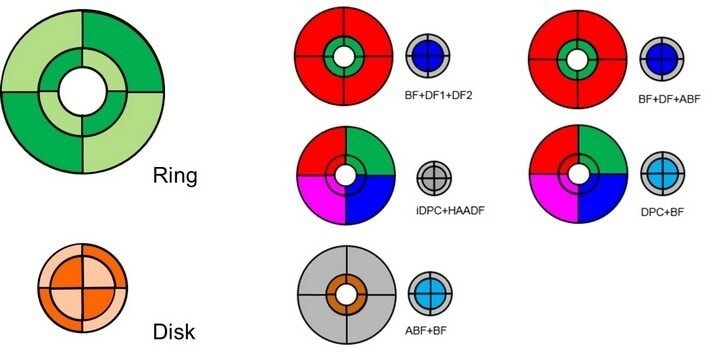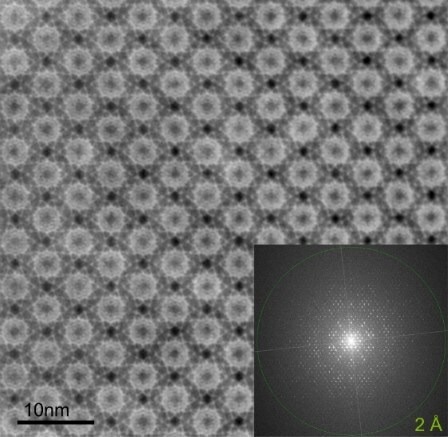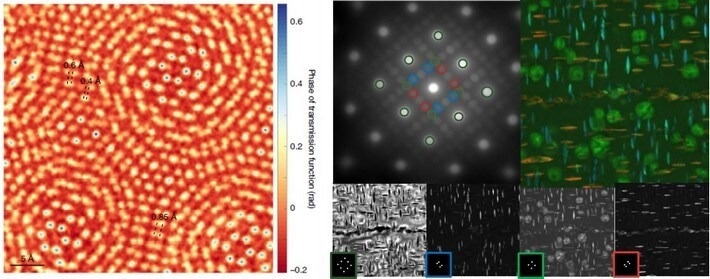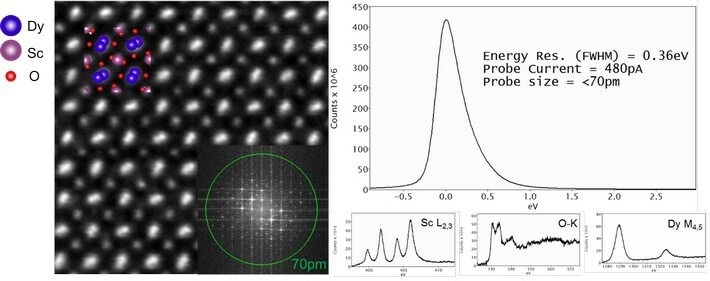Scientists need access to accurate, robust equipment that can resolve space, time, and frequency, as well as correlate form and function, to progress their understanding of complex samples and create novel materials.
Thermo Scientific Spectra 200 (S)TEM, a high-throughput, aberration-corrected (scanning) transmission electron microscope, is available for all materials science applications.
Spectra 200 Scanning Transmission Electron Microscope Advantages
All Spectra 200 (S)TEMs are supplied with new platforms that offer extraordinary mechanical stability and high imaging quality through passive and (optional) active vibration isolation.
The system is housed in a completely redesigned enclosure with an integrated on-screen display for simple sample loading and removal. Maximum flexibility for various room configurations is possible with full modularity and upgradeability between uncorrected and single-corrected configurations with variable heights.
Spectra 200 Scanning Transmission Electron Microscope Features
Powered by the Ultra-High-Brightness Cold Field Emission Gun (X-CFEG)
The Spectra 200 (S)TEM can be powered by a new-cold field emission gun (X-CFEG). The X-CFEG can be operated between 30 and 200 kV and has an exceptionally high brightness (>>1.0 × 108 A/m2/Sr/V*) and low energy spread.
This offers high-resolution STEM imaging using high probe currents for high-throughput, rapid acquisition STEM analytics. Sub-Angstrom STEM imaging (with over 1000 pA of probe current) can be achieved with the potent combination of X-CFEG and S-CORR probe aberration corrector.
![Si[110] HAADF images taken on a Spectra 200 S/TEM with probe currents ranging from 0.016 nA up to 1 nA while maintaining <76 pm STEM resolution.](https://www.azom.com/images/equipments/EquipmentImage_8820_17059069006528945.jpg)
Si[110] HAADF images taken on a Spectra 200 S/TEM with probe currents ranging from 0.016 nA up to 1 nA while maintaining <76 pm STEM resolution. Image Credit: Thermo Fisher Scientific – Electron Microscopy Solutions
To accommodate the widest range of specimens and experiments, probe currents can also be flexibly tuned from <1 pA up to the nA range with fine control of the gun and condenser optics, all with minimal impact on the probe aberrations.
To maintain the probe current, the sharp tip needs to periodically regenerate, or "flash," just like any other cold field emission source. The X-CFEG tip only needs to be flashed once a working day, which takes under a minute to complete. Even under the highest resolution imaging conditions, there is no discernible effect on the probe aberrations, and the daily tip flashing procedure does not affect the tip lifetime.
Top flashing on the X-CFEG: 60 pm resolution at 200 kV is preserved both before and after top flashing without modification of the optics. This process takes under a minute to complete and is only needed once every working day. It does not affect the lifespan of the tip.
The new generation X-CFEG yields sufficient total beam current (>14 nA) to enable standard TEM imaging experiments (for example, in situ) with large parallel probes. This makes it a uniquely all-purpose but high-performance C-FEG.
High-Resolution STEM Imaging Performance for All Accelerating Voltages
The combination of the X-CFEG, improved mechanical stability, and the most recent 5th-order S-CORR probe aberration correction provides the Spectra 200 (S)TEM with high-contrast, high-resolution imaging capabilities for accelerating voltages.
Spectra 200 (S)TEM also maintains the wide gap S-TWIN objective lens fas standard from the Themis product line. This guarantees that customers have a pole gap with "space to do more" without sacrificing spatial resolution. The images below illustrate a wide gap S-TWIN Spectra 200 (S)TEM operating at 200 kV with 48 pm resolution.
The Spectra 200 (S)TEM's intelligent software algorithms, which optimize first and second-order aberrations on any specimen (OptiSTEM+) and swiftly, reproducibly, and reliably correct up to fourth-order aberrations in the STEM probe (Auto S-CORR), further contribute to the device's ease of use.
Auto S-CORR can thus be utilized weekly to maintain high-order aberrations and OptiSTEM+ can be utilized daily to optimize image quality without the requirement for a standard specimen or manual tuning.
![Si [110] and GaN [212] taken on a Spectra 200 (S)TEM showing the specified resolution on a wide gap analytical S-TWIN pole piece (green circle) and achievable resolution (red circles). At 60 kV, 96 pm resolution is specified and at 200 kV, 60 pm is specified with an achievable resolution <48 pm](https://www.azom.com/images/equipments/EquipmentImage_8820_17059069075691790.jpg)
Si [110] and GaN [212] taken on a Spectra 200 (S)TEM showing the specified resolution on a wide gap analytical S-TWIN pole piece (green circle) and achievable resolution (red circles). At 60 kV, 96 pm resolution is specified and at 200 kV, 60 pm is specified with an achievable resolution <48 pm. Image Credit: Thermo Fisher Scientific – Electron Microscopy Solutions
The Spectra 200 (S)TEM offers STEM resolution specifications of 60 pm at 200 kV, 96 pm at 60 kV, and 125 pm at 30 kV.
Unprecedented Sensitivity With the Panther STEM Detection System
With the Panther STEM detection system, which consists of two new solid-state, eight-segment ring and disk STEM detectors (16 segments total), as well as a new data acquisition architecture, STEM imaging on the Spectra 200 (S)TEM has been reimagined. The new detector geometry provides access to sophisticated STEM imaging capabilities with the sensitivity to measure single electrons.

The 16 segmented ring and disk detectors of the Panther STEM detection system allow for a range of STEM signals without the need for multiple detectors. Image Credit: Thermo Fisher Scientific – Electron Microscopy Solutions
The whole signal is tuned and optimized to deliver extraordinary signal-to-noise imaging capabilities with very low doses. This facilitates the imaging of beam-sensitive materials.
The redesigned data acquisition infrastructure can also combine various individual detector segments and has the potential to combine detector segments in arbitrary ways. This enables the generation of novel STEM imaging techniques and the discovery of information that is not available with traditional STEM methods. The architecture is also scalable and offers an interface for synchronizing multiple spectroscopic and STEM signals.
![Comparison SrTiO₃ [001] HAADF images taken with the Panther STEM detection system with 3 pA, 1.3 pA and <1 pA of probe current. Even with probe currents <1 pA, the signal-to-noise ratio in the image allows automation routines like OptiSTEM+ to correct 1st and 2nd order aberrations in the probe forming optics, delivering sharp images.](https://www.azom.com/images/equipments/EquipmentImage_8820_17059069211977202.jpg)
Comparison SrTiO₃ [001] HAADF images taken with the Panther STEM detection system with 3 pA, 1.3 pA, and <1 pA of probe current. Even with probe currents <1 pA, the signal-to-noise ratio in the image allows automation routines like OptiSTEM+ to correct 1st and 2nd order aberrations in the probe-forming optics, delivering sharp images. Image Credit: Thermo Fisher Scientific – Electron Microscopy Solutions

Metal Organic Framework (MOF) MIL-101 imaged with 0.5 pA of beam current in STEM with iDPC at 200kV. The image is a single shot with a frame time of 23.5 seconds and the complex structure can be seen with 2 Å resolution. (Specimen courtesy of Professor Y. Han, King Abdullah University of Science and Technology.). Image Credit: Thermo Fisher Scientific – Electron Microscopy Solutions
Advanced STEM Imaging Capabilities
To collect 4D STEM data sets, the Spectra 200 (S)TEM can be set up with a Thermo Scientific Ceta Camera with speed enhancement or an electron microscope pixel array detector (EMPAD).
The EMPAD is the best detector for 4D STEM applications because of its 30–300 kV capability, high dynamic range (1:1,000,000 e- between pixels), high signal-to-noise ratio (1/140 e-), and high speed (1100 frames per second) on a 128 × 128-pixel array.

The EMPAD detector can be used for a wide variety of applications. On the left, it is used to extend spatial resolution (0.39 Å) beyond the aperture-limited resolution at low accelerating voltages (80 kV) in a bi-layer of the 2D material MoS2 (Jiang, Y. et al. Nature 559, 343–349, 2018). On the right, it is used to independently image dark field reflections, revealing the complex microstructure of the precipitates in a superalloy (Sample courtesy Professor G. Burke, University of Manchester). Image Credit: Thermo Fisher Scientific – Electron Microscopy Solutions
For 4D STEM applications requiring more pixels and EDX analysis to be integrated with every point in the STEM scan, the Ceta Camera with speed enhancement provides an alternative. For applications like strain measurement, this solution offers diffraction patterns with a higher resolution (up to 512 × 512 pixels).
New Possibilities in STEM Analytics With Spectra 200 S/TEM
The Spectra 200 (S)TEM is a powerful tool for STEM analytics. STEM EDX on Spectra 200 (S)TEM is made quick, simple, and quantifiable by the extreme brightness and low energy spread of the X-CFEG, the 5th order S-CORR probe corrector, the wide gap (S-TWIN or X-TWIN) pole piece with a portfolio of large solid angle and symmetric EDS detectors, and the integrated EDX quantification engine in Thermo Scientific Velox Software.
A variety of detector geometries are available in the Thermo Scientific EDX detector portfolio to meet your experimental needs and maximize EDX outcomes. Quantifiable data is produced by both configurations, which have symmetric designs. Holder shadowing as a function of tilt is compensated in both of the detector configurations through integrated Velox Software.
The Spectra 200 (S)TEM can be configured with Dual-X (for the largest solid angle and high-throughput STEM EDX mapping) or Super-X (for spectrum cleanliness and quantification).
A highly collimated solid angle of 0.7 Sr and a Fiori number greater than 4000 are offered by the Super-X detector system. It is intended for use in STEM EDX investigations where quantification and spectral cleanliness are essential.
A Fiori number higher than 2000 and a solid angle of 1.76 Sr are offered by the Dual-X detector system. It is intended for use in high-throughput STEM EDX experiments, like EDS tomography, or in situations where quick mapping is essential and signal yield is low.
The DyScO3 perovskite system is investigated using the Dual-X detectors in the example below. A probe with 150 pA of current and a size of less than 80 pm is delivered to the specimen using the S-CORR probe corrector’s resolving power and the X-CFEG’sultra-high brightness (>>1.0 × 108 A/m2/Sr/V).
These high-brightness probe conditions allow for quick EDX mapping with high sampling and high SNR, generating sub-Å spatial information in an elemental, raw, and unfiltered EDX map. Up to 90 pm resolution is displayed by the Sc map’s fast Fourier transform.

DyScO3 specimen investigated with the powerful combination of ultra-high brightness X-CFEG, S-CORR, and the large solid angle (1.76 Sr) of the Dual-X detectors, resulting in high signal-to-noise ratio, atomic resolution (up to 90 pm), unfiltered EDX maps (Sample courtesy Professor L.F. Kourkoutis, Cornell University). Image Credit: Thermo Fisher Scientific – Electron Microscopy Solutions
The ultra-high brightness (>>1.0 × 108 A/m2/Sr/V*) and intrinsically high energy resolution (<0.4 eV) of the X-CFEG, which are delivered simultaneously in the STEM probe, have also accelerated electron energy loss spectroscopy on Spectra 200 (S)TEM.
The probe in the figure below has a narrow energy spread (0.36 eV), a high current (480 pA), and a high spatial resolution (65 pm). These characteristics make it ideal for collecting the Dy, Sc, and O core loss edges in the STEM image with high energy resolution, signal-to-noise ratio, and spatial resolution.

DyScO3 specimen investigated with a Spectra 200 (S)TEM. The combined ultra-high brightness of the X-CFEG, intrinsically low energy spread of the source (<0.40 eV), and resolving power of the S-CORR results in high signal-to-noise ratio, Sc, O, and Dy core loss edges with a sub-70 pm STEM probe (Sample courtesy Professor L.F. Kourkoutis, Cornell University). Image Credit: Thermo Fisher Scientific – Electron Microscopy Solutions
Specifications
Source: Thermo Scientific – Materials and Structural Analysis
| . |
. |
| Spectra 200 (S)TEM |
- Probe corrector:
- Energy spread: 0.4 eV
- Information limit: 110 pm
- STEM resolution: 60 pm (136 pm @ 30 kV)
- Uncorrected:
- Energy spread: 0.4 eV
- Information limit: 110 pm
- STEM resolution: 164 pm
|
| Source |
- X-CFEG: Ultra-high-brightness cold field emission gun with energy resolution of <0.4 eV
- Flexible high-tension range from 30 – 200 kV
|
| Analytics and detectors |
- Super-X/Dual-X EDS options, integrated software, and the Gatan Ultrafast EELS/DualEELS options together provide up to 1000 sp/s of simultaneous EDS and EELS data acquisition
- Analytics for live peak identification and background fitting during ultra-fast EDS acquisition
- Symmetric EDS detector design allows for combined tomographic EDS
|
| Available detector options |
- HAADF detector
- On-axis solid state, 8 segmented BF and ADF detectors (16 segments in total)
- Thermo Scientific Ceta 16M Camera (optionally with speed enhancement)
- Gatan OneView/OneView IS cameras
- Gatan energy filter series
- Electron microscope pixel array detector (EMPAD)
|